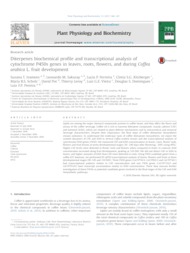Diterpenes biochemical profile and transcriptional analysis of cytochrome P450s genes in leaves, roots, flowers, and during Coffea arabica L. fruit development.
Diterpenes biochemical profile and transcriptional analysis of cytochrome P450s genes in leaves, roots, flowers, and during Coffea arabica L. fruit development.
Autoria: IVOMOTO, S. T.; SAKURAY, L. M.; FERREIRA, L. P.; KITZBERGER, C. S. G.; SCHOLZ, M. B. S.; POT, D.; LEROY, T.; VIEIRA, L. G. E.; DOMINGUES, D. S.; PEREIRA, L. F. P.
Resumo: Lipids are among the major chemical compounds present in coffee beans, and they affect the flavor and aroma of the coffee beverage. Coffee oil is rich in kaurene diterpene compounds, mainly cafestol (CAF) and kahweol (KAH), which are related to plant defense mechanisms and to nutraceutical and sensorial beverage characteristics. Despite their importance, the final steps of coffee diterpenes biosynthesis remain unknown. To understand the molecular basis of coffee diterpenes biosynthesis, we report the content dynamics of CAF and KAH in several Coffea arabica tissues and the transcriptional analysis of cytochrome P450 genes (P450). We measured CAF and KAH concentrations in leaves, roots, flower buds, flowers and fruit tissues at seven developmental stages (30e240 days after flowering - DAF) using HPLC. Higher CAF levels were detected in flower buds and flowers when compared to fruits. In contrast, KAH concentration increased along fruit development, peaking at 120 DAF. We did not detect CAF or KAH in leaves, and higher amounts of KAH than CAF were detected in roots. Using P450 candidate genes from a coffee EST database, we performed RT-qPCR transcriptional analysis of leaves, flowers and fruits at three developmental stages (90, 120 and 150 DAF). Three P450 genes (CaCYP76C4, CaCYP82C2 and CaCYP74A1) had transcriptional patterns similar to CAF concentration and two P450 genes (CaCYP71A25 and CaCYP701A3) have transcript accumulation similar to KAH concentration. These data warrant further investigation of these P450s as potential candidate genes involved in the final stages of the CAF and KAH biosynthetic pathways.
Ano de publicação: 2017
Tipo de publicação: Artigo de periódico
Unidade: Embrapa Café
Palavras-chave: Cafestol, Café, Gene expression, High performance liquid chromatography, Kahweol, RT-qPCR
Observações
1 - Por padrão são exibidas publicações dos últimos 20 anos. Para encontrar publicações mais antigas, configure o filtro ano de publicação, colocando o ano a partir do qual você deseja encontrar publicações. O filtro está na coluna da esquerda na busca acima.
2 - Para ler algumas publicações da Embrapa (apenas as que estão em formato ePub), é necessário ter, no celular ou computador, um desses softwares gratuitos. Sistemas Android: Google Play Livros; IOS: iBooks; Windows e Linux: software Calibre.
Acesse outras publicações
Acesse a Base de Dados da Pesquisa Agropecuária (BDPA) para consultar o acervo completo das bibliotecas da Embrapa.

